Dividend Investing for Beginners: Easy Guide to Passive Income
Learn dividend investing for beginners. Our guide covers key strategies to generate passive income with dividend stocks. Start investing today!
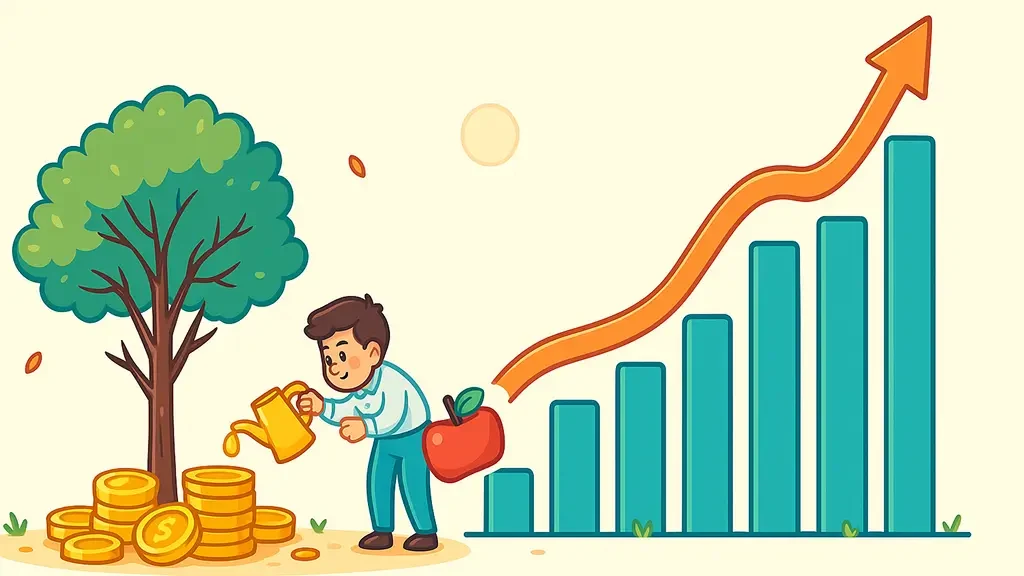
For a beginner, the idea of dividend investing is refreshingly simple: you buy shares in companies that send you a cut of their profits. Think of it like owning a small slice of a successful rental property. You don't have to manage the tenants or fix leaky faucets, but you still get to collect regular rent checks just for being an owner.
What Is Dividend Investing And How Does It Work
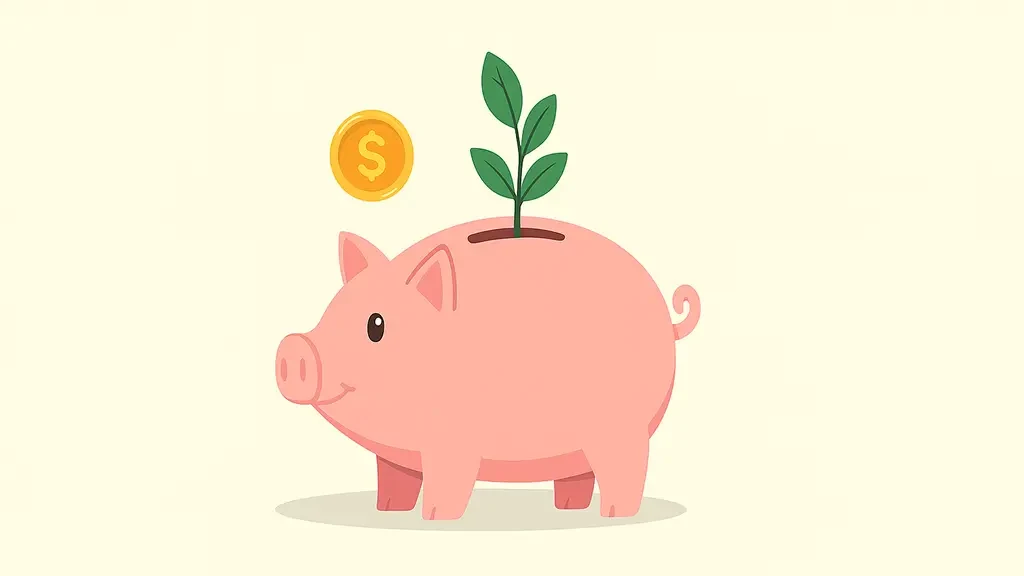
Let's imagine you own a thriving apple orchard. At the end of the year, after you've sold enough apples to cover all your costs and set aside money to plant new trees, you have a massive surplus. What do you do with it? As the owner, you take a portion of those extra apples home.
Dividend investing is built on the exact same principle. When you buy a stock, you're not just buying a ticker symbol on a screen; you're buying a piece of a real business. When that company turns a profit, its board of directors might decide to distribute some of those earnings back to its owners—people like you. That payment is called a dividend.
This isn't some complex, high-frequency trading strategy. It’s a patient, straightforward approach to building wealth over the long haul. The magic is that you win in two ways: you get the steady income from the dividends, and you have the potential for the stock's price to grow over time.
The Core Concept of Shared Success
So why do companies do this? Usually, it’s the financially healthy, mature businesses that generate more cash than they know what to do with. Instead of letting that cash pile up and do nothing, they reward the people who invested in them.
A dividend payment is more than just cash in your pocket. It’s a powerful signal of a company's financial stability and its confidence in the future. It's a tangible return on your investment, delivered right to your brokerage account.
A dividend is basically the company saying, "Thanks for being an owner." It transforms your stock from a simple number into a productive asset that generates real cash flow for you.
At its heart, dividend investing is a fantastic strategy for generating passive income. The goal is to get your money working for you, and these payments often arrive on a predictable schedule—typically every three months (quarterly)—providing a reliable stream of cash.
How You Get Paid
The best part? The whole process is incredibly simple and almost entirely automated. When a company announces it will pay a dividend, it also sets a payment date. As long as you own the stock by a specific cutoff point (known as the ex-dividend date), you're on the list to get paid.
On the payment date, the cash shows up directly in your brokerage account. No paperwork, no hassle.
From there, you have a couple of great options:
- Spend it: Use the cash to pay bills, treat yourself, or fund a vacation. It's your money.
- Reinvest it: Automatically use the dividend payment to buy more shares of the very same stock. This is how you start compounding your growth and making your investment grow even faster over time.
This approach is especially great for beginners because it provides constant, positive reinforcement. Even when the stock market is bouncing all over the place, seeing those regular cash payments can help you stay disciplined and focused on your long-term goals. It's a patient, proven path to building real wealth.
Understanding The Language Of Dividend Investing
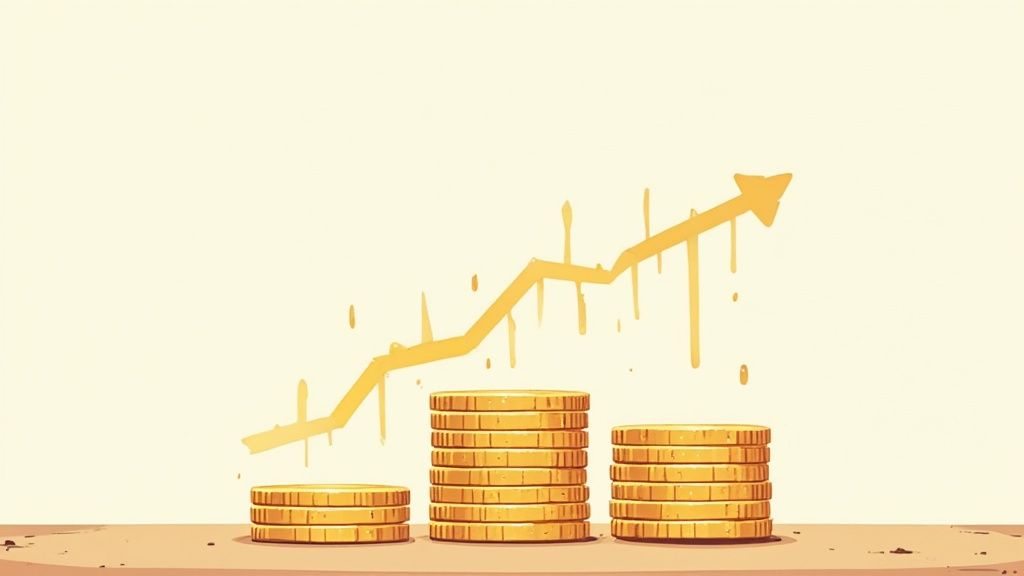
To start investing with real confidence, you need to speak the language. Forget the dry, academic definitions—we're going to break down the essential terms you'll see everywhere.
Think of it like learning the basic rules before playing a new sport. Once you know what a few key stats mean, you can start picking your winning team. These metrics are your tools for spotting healthy, reliable companies that will pay you for years to come.
Dividend Yield: Your Annual Cash-on-Cash Return
The first term you'll hear constantly is dividend yield. This is the simplest way to think about your "return" in pure cash terms. It tells you how much income you get each year for every dollar you invest.
The math is easy: take the total annual dividend per share and divide it by the stock's current price. If a stock trades at $100 and pays out $3 per year in dividends, its yield is 3%.
A higher yield means more cash in your pocket. But be careful—a suspiciously high yield can sometimes be a red flag. It’s a number you always need to look at in context.
Payout Ratio: A Peek Into Company Health
Next up is the payout ratio. This is like a financial health check for a company. It reveals what percentage of its profits are being handed back to shareholders as dividends.
Imagine a company earns $100,000 in profit. If it pays $40,000 in dividends, its payout ratio is 40%. The other 60% stays in the business to fund growth, pay down debt, or build a rainy-day fund.
A healthy payout ratio signals that a dividend is sustainable. It means the company isn't stretching its finances just to keep shareholders happy, leaving plenty of cash for its own needs.
A payout ratio that creeps above 80% consistently could be a warning sign. It suggests the dividend might be at risk of a cut if the company hits a rough patch.
Before we move on, let's put the most important terms into a quick-reference table. This will help you get comfortable with the lingo you'll see on any financial site.
Key Dividend Terms Every Beginner Should Know
Getting a handle on these terms is the first big step. They're the numbers that tell the story behind the dividend.
The All-Important Dividend Dates
Knowing the dividend timeline is crucial—it determines exactly when you need to own a stock to actually get paid. There are four key dates to circle on your calendar.
Let's break them down:
- Declaration Date: This is the official announcement. The company’s board says, "Hey, we're paying a dividend!" They’ll state the amount and lock in the other important dates.
- Ex-Dividend Date: This is the one that matters most to you. You must own the stock before this date to qualify for the upcoming payment. If you buy on or after this date, the seller gets the dividend, not you.
- Record Date: This is simply the company's housekeeping day. They check their books to see who the official shareholders are. It’s usually just one business day after the ex-dividend date.
- Payment Date: Payday! This is when the cash finally hits your brokerage account.
Keeping track of these dates, especially the ex-dividend date, is fundamental to managing your income flow. Fortunately, platforms like PinkLion have dividend calendars that do the tracking for you, so you never miss a payment you've earned. Once you master this vocabulary, you’re well on your way.
How Dividends Build Real Generational Wealth
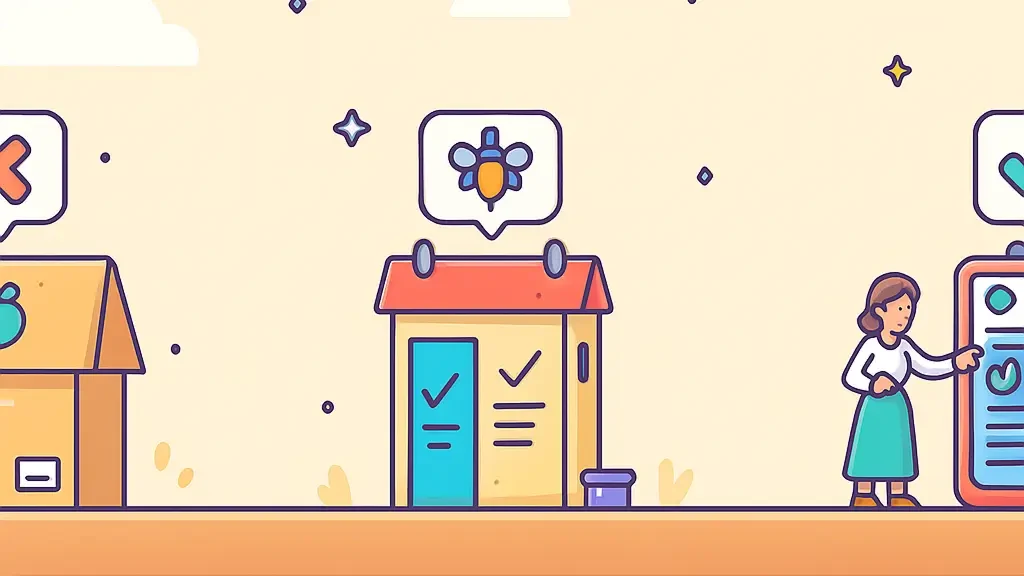
Getting that first dividend payment feels like a small win. But the real magic isn’t about cashing those little checks. It’s about turning them into a powerful, self-sustaining wealth machine through the timeless principle of compounding.
Think of a snowball rolling down a hill. As it moves, it picks up more snow, growing bigger and moving faster with every rotation. Reinvesting your dividends works the exact same way. Each payment you get is used to buy more shares, which in turn generate even more dividends.
This simple cycle is the secret ingredient that transforms dividend investing from a modest income strategy into a serious tool for building long-term wealth. It’s a patient game, but the results over a few decades can be absolutely staggering.
The Tale Of Two Investors
To see this in action, let's imagine two friends, Alex and Ben. They each invest $10,000 into the same dividend stock. This stock has a 4% annual yield and its share price grows by an average of 6% per year.
- Ben spends his dividends. Every year, he takes his $400 dividend payment and uses it for everyday expenses.
- Alex reinvests his dividends. He uses a Dividend Reinvestment Plan (DRIP) to automatically funnel his $400 back into buying more shares.
After the first year, you’d barely notice a difference. But fast-forward 30 years, and the gap between them is enormous.
Ben still has his original shares, which have grown nicely in value. His portfolio is now worth about $57,435, and he's collected a total of $12,000 in cash over the years. A solid return, no question.
Alex, however, is playing a completely different game. By letting his dividends compound, his portfolio has snowballed into roughly $123,550. He never invested a single extra dollar out of pocket, yet his wealth is more than double Ben’s. He simply let his investment fund its own growth.
Compounding through reinvested dividends is the most powerful force in finance. It’s what separates good returns from life-changing wealth, allowing your money to do the heavy lifting for you.
Dividends As A Portfolio Stabilizer
Beyond pure growth, dividends also offer a crucial psychological and financial cushion, especially when the market gets choppy. When stock prices are tanking, it's easy to panic. But dividend investors have a secret weapon: consistent cash flow.
Even as share prices drop, healthy companies keep paying their dividends. That regular income acts as a stabilizing force, softening the blow of paper losses and giving you the confidence to stick with your plan for the long haul.
This isn’t just a feeling—it’s a historically proven benefit. Since 1987, about 55% of the total market returns in global equities came from reinvesting dividends, not just price appreciation. During downturns, dividends provided an average annual return of around 3% while price returns plunged to roughly negative 15%. That’s a powerful buffer.
This stabilizing effect is a huge reason why the strategy is so popular among long-term investors. For those looking to see how dividend investing fits into a larger strategy, resources on comprehensive retirement planning can offer a bigger picture.
Building Your Wealth Engine
The key takeaway here is that dividends offer a dual benefit. They provide a reliable income stream that you can either spend or, more powerfully, reinvest to fuel exponential growth.
- In Bull Markets: They add another layer of returns on top of rising stock prices.
- In Bear Markets: They deliver a comforting stream of cash that reduces volatility and helps you weather the storm.
Platforms like PinkLion make this incredibly easy with features like dividend tracking and forecasting. You can see your expected cash flow, monitor when payments hit your account, and visualize how reinvesting those dividends will accelerate your portfolio’s future value. This turns the abstract idea of compounding into a tangible, predictable part of your financial plan.
How To Find Great Dividend Stocks For Your Portfolio
Alright, now that you see how dividends can build wealth, it's time to put on your detective hat. Finding great dividend-paying companies is about more than just grabbing the one with the highest yield. It’s about digging deeper to find businesses with the financial muscle to keep paying you, year in and year out.
Your mission is to find companies that not only pay dividends but can also protect and grow those payments over time. Think of it this way: a healthy business is the engine that drives a reliable dividend. That means focusing on financial strength and staying power before you even glance at the yield.
Look For a Long History of Dividend Payments
The past doesn't guarantee the future, but with dividends, it's a pretty powerful clue. A company that has consistently paid dividends for 10, 20, or even 50 years has shown an incredible commitment to its shareholders. It’s a sign that sharing profits is baked into the company’s DNA.
This kind of track record proves the business has weathered recessions, market crashes, and massive industry shifts—all without cutting its shareholder payments. A long history signals resilience and financial discipline, two traits you absolutely want in a dividend investment.
Meet the Dividend Aristocrats
Some companies take this commitment to a whole other level. These are the Dividend Aristocrats—an elite group of companies in the S&P 500 that have not just paid, but increased their dividends for at least 25 consecutive years.
These are often household names with fortress-like positions in their markets. Think of them as the gold standard of dividend reliability. When you invest in an Aristocrat, you're partnering with a business that has proven its ability to grow profits and share that growth with you through thick and thin.
Analyze The Company's Financial Health
A dividend is only as safe as the company paying it. Before you invest, you need to pop the hood and check the engine. Healthy cash flow is non-negotiable, since dividends are paid directly from a company's earnings.
Here are a few quick checkpoints:
- Consistent Profitability: Is the company actually making money year after year? A history of steady earnings suggests the business can easily support its dividend.
- Low Debt: Piles of debt can strangle a company, forcing it to choose between paying lenders and paying you. A strong balance sheet with manageable debt is a huge green light.
- A Sustainable Payout Ratio: As we covered, a payout ratio below 80% is a good sign. It means the company has plenty of breathing room to maintain its dividend and reinvest in its own growth.
Beware The Dangerous Yield Trap
It’s tempting, I get it. You see a stock with a massive dividend yield and your eyes light up. But be warned: an unusually high yield is often a major red flag. This is what's known as a "yield trap."
A yield trap happens when a stock's price has cratered, but the company hasn't cut its dividend yet. This makes the yield look artificially high, but it's often a screaming signal that the market expects a dividend cut is right around the corner because the business is in serious trouble.
Chasing a monster yield without checking the company's health is one of the most common mistakes new investors make. Always ask why a yield is so high. A safe 3% yield from a stable, growing company is infinitely better than a risky 10% yield from a business on the brink of collapse.
This is exactly why dividend investing tends to favor mature, stable companies. Historically, these businesses offer less drama and have shown they can hold their ground during market downturns. For instance, between 2018 and 2023, dividend stocks often lagged flashy growth stocks in boom years but performed much better in the down year of 2022, losing far less than the broad market. You can explore more on how different stock types perform on Morningstar.com.
Remember, building a strong portfolio isn't about finding a single "perfect" stock. It's about combining several great ones across different industries. To learn more about this crucial principle, check out our guide on how to diversify your investment portfolio. A diversified basket of high-quality dividend payers is the smartest way to lower your risk and ensure that income stream stays reliable.
Simple Dividend Strategies You Can Start Today
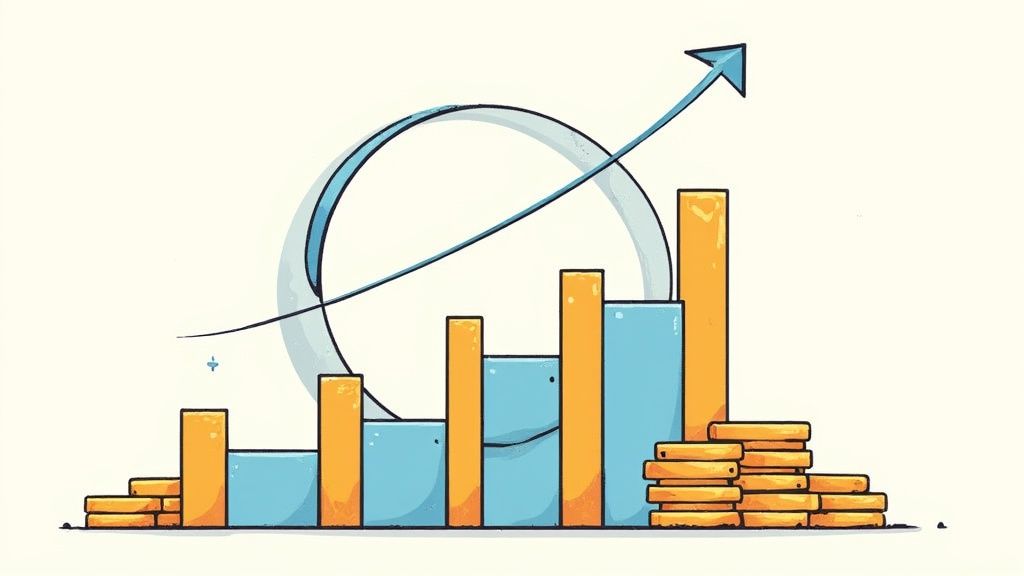
Knowing the theory behind dividend investing is one thing, but taking action is what actually builds wealth. Getting started can feel intimidating, so let's cut through the noise and focus on two simple, effective strategies perfect for anyone new to the game.
The goal isn't to become a stock-picking wizard overnight. It's about building a reliable income stream, smartly and sustainably. Each of these paths offers a different blend of control and convenience, so your choice will come down to your financial goals, how much time you want to spend, and your comfort with risk.
Strategy 1: The Focused Approach of Individual Dividend Stocks
The first route is the classic one: buying shares in individual, high-quality companies. This is where you hand-pick the businesses you want to own, giving you the most control over what goes into your portfolio.
The key here is to start slow and stay diversified. You don’t need to find ten perfect stocks on day one. Begin by researching a few solid companies—maybe a couple of the "Dividend Aristocrats" we mentioned earlier—and make your first purchase. Over time, you can gradually add more stocks from different sectors of the economy.
This method is incredibly rewarding as you get to know the businesses you own, but it definitely requires more upfront research and ongoing attention.
Strategy 2: The "Starter Pack" Approach of Dividend ETFs
If researching individual companies sounds like a chore right now, there’s an even easier way to begin: dividend ETFs (Exchange-Traded Funds). Think of a dividend ETF as a pre-packaged bundle of dividend-paying stocks.
With a single purchase, you instantly own small pieces of dozens, or even hundreds, of different companies. It's like buying a "dividend investing starter pack" that gives you immediate diversification and takes the pressure off of picking individual winners and losers. For many beginners, this is the ideal low-stress entry point.
A dividend ETF handles the heavy lifting of stock selection and diversification for you. This allows you to benefit from the power of dividend investing without the time commitment of managing a portfolio of individual stocks.
And these strategies work. Long-term data shows that from mid-2001 through mid-2023, the Dow Jones U.S. Dividend 100 Index delivered an annualized total return of 11.7%, beating the broader market’s 10.2% return. This highlights the powerful combo of dividend income and compounding, a concept detailed further in this S&P Global analysis.
Choosing The Right Path For You
So, which way should you go? Honestly, there's no single right answer, and many savvy investors use a mix of both. To help you decide, let's break it down side-by-side.
Individual Stocks: Offer greater control and potentially higher returns if you pick well. The trade-off? They demand more research and carry higher risk if you don't diversify properly. Understanding market dynamics is crucial, and you can learn more about how to analyze market trends in our detailed guide.
Dividend ETFs: Provide instant diversification and are incredibly convenient. They are the definition of a "set it and forget it" strategy, but you give up control over the specific stocks you own and have to pay a small management fee.
Ultimately, the best strategy is the one you can stick with for the long haul. Whether you choose the hands-on approach of individual stocks or the beautiful simplicity of an ETF, the most important step is just getting started.
Common Dividend Investing Mistakes And How To Avoid Them
Knowing what to do is only half the battle. Just as important is knowing what not to do. Most new dividend investors stumble into a few predictable traps that can seriously derail their progress. If you learn to spot these pitfalls early, you can sidestep them entirely and build smarter, more durable investing habits from the start.
The first and most common mistake is falling for the "yield trap." You stumble upon a stock with an eye-popping dividend yield of 10% or more and think you've struck gold. In reality, an unusually high yield is almost always a massive red flag, not a golden ticket.
This usually happens when a company's stock price has cratered because of deep-seated business problems, but the board hasn't gotten around to cutting the dividend yet. The market is essentially screaming that the payout is unsustainable. Chasing these high-risk yields is a fast track to losing both your income stream and your original investment when the inevitable dividend cut finally happens.
Forgetting To Diversify Your Income Streams
Another classic rookie error is putting all your eggs in one basket. It’s easy to do—you find a fantastic dividend-paying company in the tech sector and get so excited that you pour a huge chunk of your capital into it. Even if the company is solid, this lack of diversification ties your entire dividend income to the fortunes of a single company or industry.
If that sector hits a rough patch, your income is suddenly at risk. The smarter play is to spread your investments across a variety of unrelated industries, like healthcare, consumer goods, utilities, and financials. That way, if one part of your portfolio is struggling, the others can keep your income stream flowing. A well-diversified portfolio is your best defense against market surprises. You can get a deeper look into this process in our guide on how to evaluate investment opportunities.
Letting Emotions Drive Your Decisions
Finally, letting your gut reactions take over can be an investor's worst enemy. Picture this: you own shares in a blue-chip company that has reliably paid dividends for decades. Then a recession hits, and to conserve cash, the company announces a temporary dividend reduction. The knee-jerk reaction for many is to panic and dump the stock.
Panicking during a temporary setback is often a costly mistake. Strong, well-run companies frequently recover from tough economic cycles and reinstate or even grow their dividends once conditions improve.
Selling in a downturn just locks in your losses and guarantees you'll miss the recovery. Successful dividend investing requires a long-term mindset. It's about trusting the quality of the businesses you own and having the patience to ride out the inevitable bumps in the road.
To steer clear of these common mistakes, just stick to these simple rules:
- Question High Yields: Always dig into why a yield is sky-high before you even think about investing. A safe 4% from a healthy company beats a risky 12% any day.
- Diversify Broadly: Aim to own at least 10-15 different stocks spread across five or more distinct sectors to protect your income.
- Think Long-Term: Focus on the company's financial health and business fundamentals, not its day-to-day stock price wiggles or temporary dividend changes.
Your Dividend Investing Questions Answered
As you get ready to dive in, a few practical questions are probably bouncing around in your head. Let's tackle the most common ones beginners have, giving you the clear, straightforward answers you need to get started with confidence.
How Much Money Do I Need To Start Dividend Investing?
Honestly? You can get started with $5 or $10. Thanks to fractional shares—a feature nearly every modern brokerage offers—you can buy a small slice of almost any company, no matter how much a single share costs.
The secret isn't how much you start with; it's about building the habit of investing regularly. Kicking things off early with small, consistent contributions is way more powerful than waiting years to start with a bigger pile of cash.
Are Dividends A Guaranteed Payment?
Nope. Dividends are never guaranteed. A company's board of directors can decide to raise, lower, or even cancel them at any time, depending on how the business is doing or where they want to focus their money.
This is precisely why we hunt for financially healthy companies. A long, unbroken history of paying and growing dividends is a powerful signal. It shows a deep commitment to shareholders and is one of the best signs that those payments will keep coming.
A dividend is a reward, not a right. Your research into a company's financial health is what turns a hopeful investment into a reliable income stream.
How Often Will I Get Paid Dividends?
That all depends on the company. Here in the U.S., the most common rhythm is quarterly, which means you get paid four times a year.
But the schedules can vary a lot. Some stocks and many dividend-focused ETFs actually pay out monthly, which is fantastic for smoothing out your cash flow. Others might pay semi-annually or just once a year.
What Is A DRIP And Should I Use It?
DRIP is short for Dividend Reinvestment Plan. It’s a simple, automated feature that takes the cash dividends you receive and uses them to buy more shares of that same stock—often in tiny, fractional amounts.
For anyone focused on long-term growth, a DRIP is one of the most powerful tools in your arsenal. It puts the magic of compounding on autopilot, making sure your investment grows as fast as it can without you lifting a finger or paying extra fees. It is the ultimate "set it and forget it" wealth-building machine.
Ready to put this knowledge into action? PinkLion gives you the tools to track your dividends, forecast your future income, and see the power of reinvesting in real-time. Take control of your financial future by signing up for free at https://pinklion.xyz.
